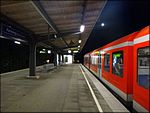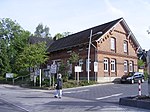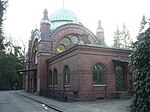Ohlsdorf Cemetery
Burial sites of the House of CirksenaCemeteries in HamburgCommonwealth War Graves Commission cemeteries in GermanyGeography of HamburgMuseums in Hamburg ... and 5 more
Rural cemeteriesTourist attractions in HamburgWorld War II cemeteries in GermanyWorld War II memorials in GermanyWorld War I cemeteries in Germany

Ohlsdorf Cemetery (German: Ohlsdorfer Friedhof or (former) Hauptfriedhof Ohlsdorf) in the Ohlsdorf quarter of the city of Hamburg, Germany, is the biggest rural cemetery in the world and the fourth-largest cemetery in the world. Most of the people buried at the cemetery are civilians, but there is also a large number of victims of war from various nations. The cemetery notably includes the Old Hamburg Memorial Cemetery (Althamburgischer Gedächtnisfriedhof, formerly Ehrenfriedhof) with the graves of many notable Hamburg citizens.
Excerpt from the Wikipedia article Ohlsdorf Cemetery (License: CC BY-SA 3.0, Authors, Images).Ohlsdorf Cemetery
Mittelallee, Hamburg Ohlsdorf (Hamburg-Nord)
Geographical coordinates (GPS) Address Nearby Places Show on map
Geographical coordinates (GPS)
| Latitude | Longitude |
|---|---|
| N 53.624722222222 ° | E 10.061666666667 ° |
Address
Friedhof Ohlsdorf (Kapelle 9) (Kapelle 9)
Mittelallee
22337 Hamburg, Ohlsdorf (Hamburg-Nord)
Germany
Open on Google Maps









